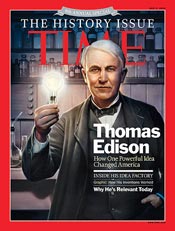The science books today call it “thermionic emission” [the conversion of heat directly to electricity], but its original name was the Edison effect. It began with the emission of electrons from a hot light bulb filament, soon to become the very basics of vacuum tubes, which led to practical radio, electronic signal amplification, telecommunications, and TV. Vacuum tubes were replaced later in the 1960s by transistors—and then even later, integrated circuits. All this led to today’s ubiquitous computers and hand held devices. It all started with Thomas Edison.
While working to improve the longevity of his light bulb filaments (1882), Edison and his staff were noticing a certain blackening of early light bulbs. Experimenting, Edison inserted another wire into the light bulb, above the filament itself. When the light bulb was switched on, this configuration allowed a current to flow from the hot filament thru the vacuum inside the bulb, to the newly inserted wire. Edison soon learned he could control the thru vacuum flow by how much positive voltage he applied to the wire.
Named the Edison effect, what Edison really discovered was that “electrons” could be literally boiled off the hot filament and collected by the wire. Electrons were not specifically named as such at that time, and would not be so until 1897 (J. J. Thomson). Edison had stumbled upon the modern electronic age.
Although not able to comprehend the vast potential and theory behind his discovery, he did file a patent that used this finding in what has come to be known as the first electronic patent, “Electrical Indicator”, U.S. patent 307,031–November 15, 1883. The electrical indicator was envisioned by Edison to be used to detect changes in voltage within an electrical distribution network. At this time he was working on his Pearl Street electric distribution demonstration system as well as other similar projects, so it is natural he saw an application here first.
John Ambrose Fleming (1904) and Lee De Forest (1906) would later build upon Edison’s discovery and introduce the diode and triode vacuum tubes respectively, setting the stage for modern radio and electronics. On Christmas Eve, 1906, Reginald Aubrey Fessenden [later to become a giant in electronics and a very famous inventor], made the first radio broadcast. Fessenden had worked at Edison’s legendary West Orange labs from 1886-1890.
In a way, Fessenden closes the loop from Edison’s thermionic emission discovery in 1882. In just about one generation, 24 years, Edison’s discovery becomes an integral part of what would become the greatest industrial revolution, the telecommunications revolution…still robust and rapidly evolving today.
 “The man who doesn’t make up his mind to cultivate the habit of thinking misses the greatest pleasure in life.”
“The man who doesn’t make up his mind to cultivate the habit of thinking misses the greatest pleasure in life.”
Time ® is a registered trademark of Time Inc.





